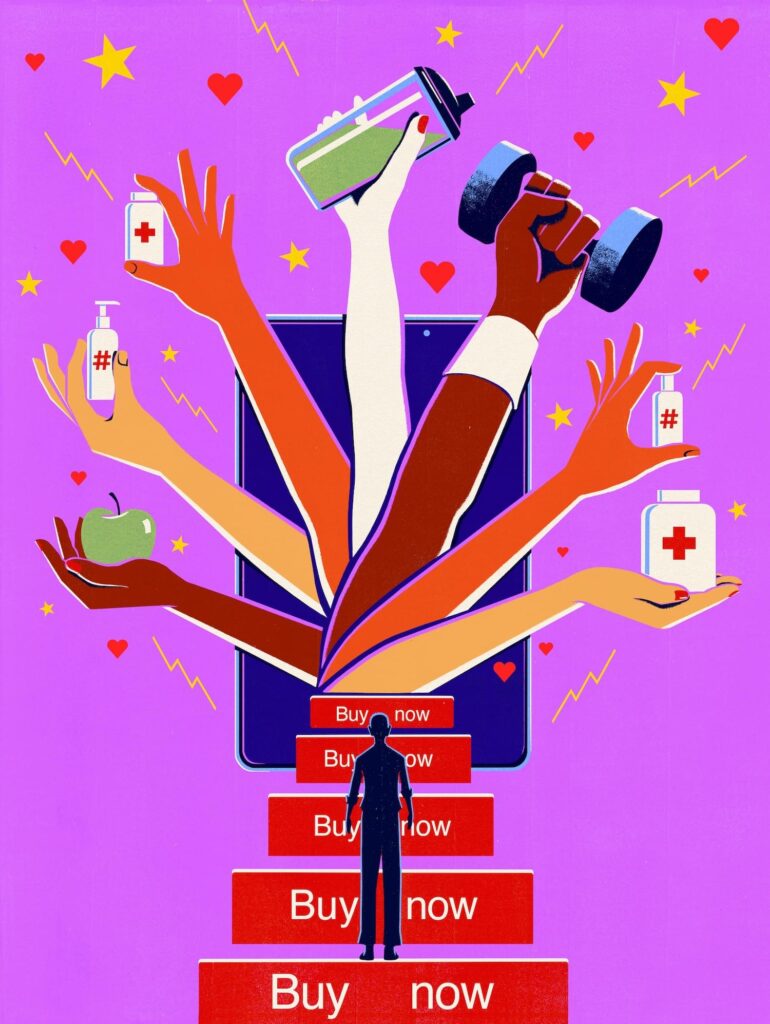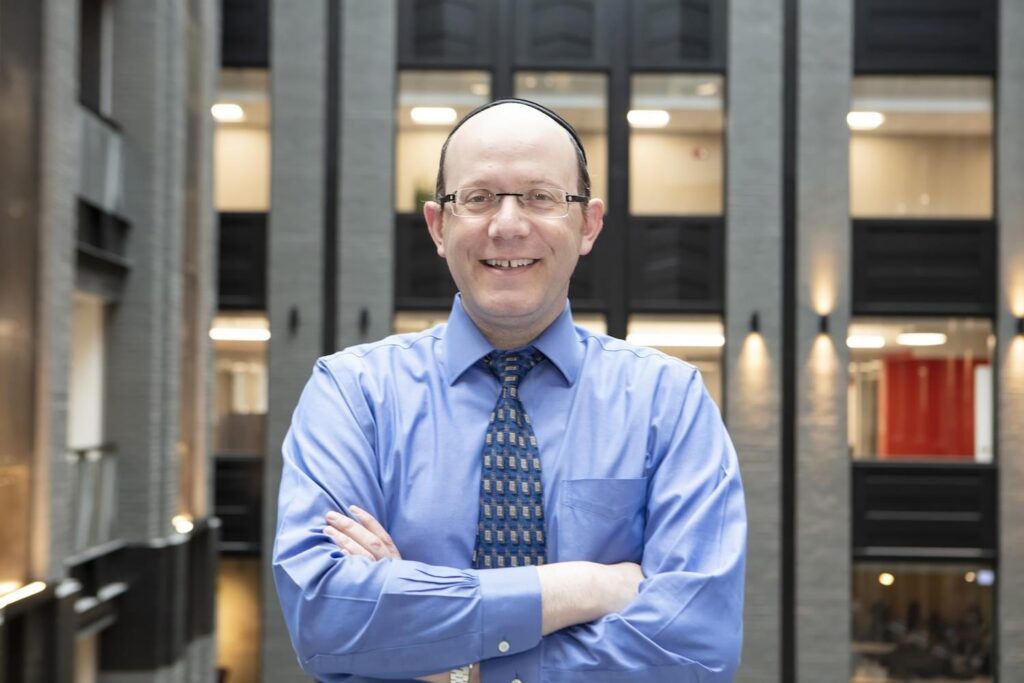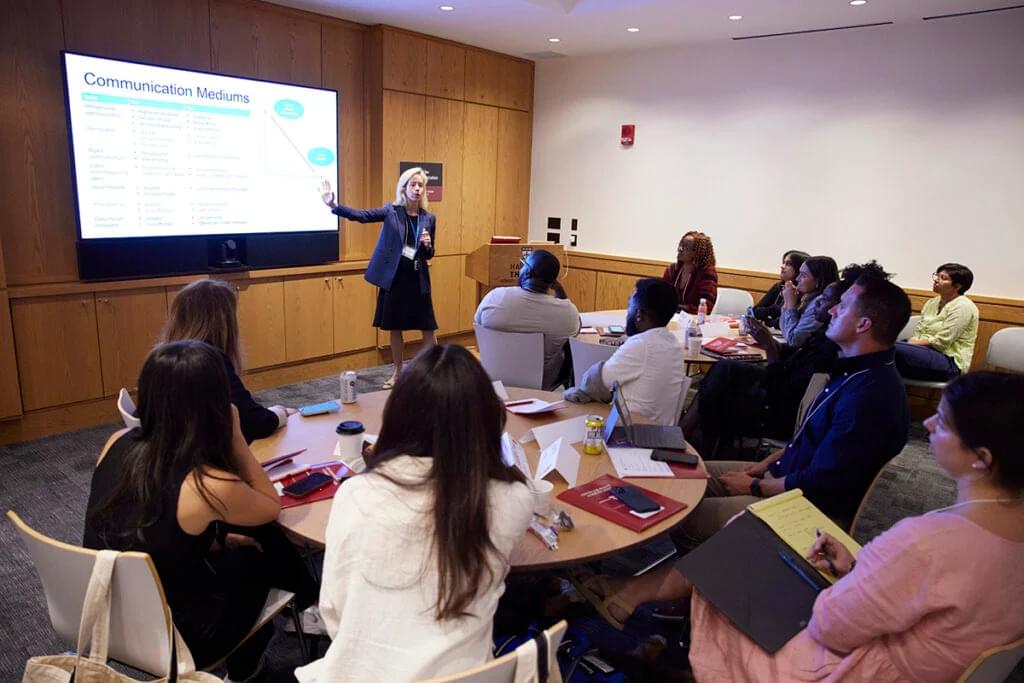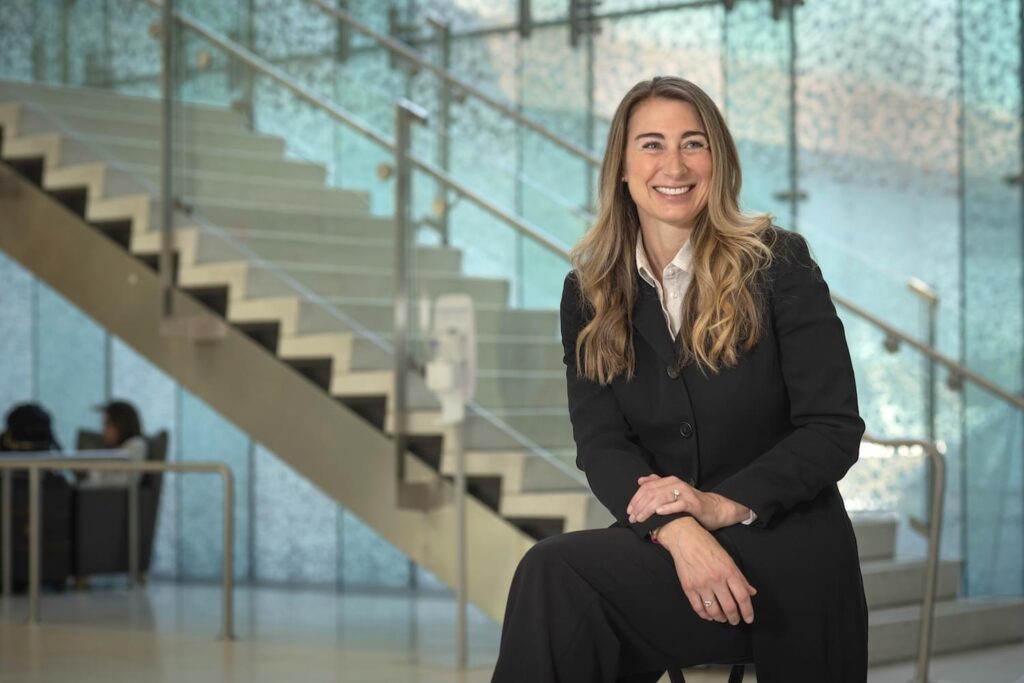
What You Will Learn:
- Social media and influencer culture affect real-world patient behavior and decision-making.
- Brigham experts explain behavioral trends leading people to accept dubious health claims or misinformation.
- They offer suggestions for individuals to prevent misinformation from impacting their well-being.
Prologue
I fell for it.
At the end of another stressful day, I absentmindedly scrolled through my social media feed. The next thing I knew, I was nodding along to the video of a fitness influencer, as though she were a trusted doctor.
I knew she wasn’t a licensed trainer, nutritionist, or physician. Yet with words like “inflammation” and “hormonal imbalance,” she convinced me within seconds that my exercise routine was terrible, my diet in shambles, and I needed to click immediately on “Shop now” to buy a protein powder supplement formulated specifically for women that the manufacturer was paying her to promote.
Selling fear and shame
“Marketing for these products plays on fears: fear of missing out, of inadequacy, of being inferior,” says Natalie Dattilo, PhD, clinical psychologist at the Brigham. “These social media trends don’t just affect our financial health. They keep us searching for something outside ourselves to fix our problems, which can disempower us and make us feel overly reliant on some unproven supplement or protocol.”
With many social media platforms allowing users to purchase products without leaving the app, it’s easier than ever to act immediately on impulses.
“It creates an emotional and psychological backlash,” Dattilo says. “We feel pressure to lean on untested products and methods of health and wellness, when what you really need to do is partner with your doctor.”
The Rise of an Infodemic
Health misinformation has always existed. But in 2020, the World Health Organization classified our information environment as an “infodemic”—an overabundance of information that obscures evidence-based guidance. The main driver behind this phenomenon? Social media.
“Social media is a massive amplifier,” says Michael Klompas, MD, MPH, a Brigham infectious disease specialist and hospital epidemiologist. “It gives one the capacity to spread fake theories widely and with incredible uptake.”
Klompas led the Brigham’s Infection Control team during the COVID-19 pandemic and the 2022 mpox outbreak. Both diseases have been targets of misinformation. Some extreme viewpoints about these diseases—and others—have entered the mainstream thanks to social media algorithms and weak content regulation on many platforms.
“There were always people who had outlier opinions, but we never heard them. With social media, all voices can be heard,” explains Klompas. “This has increased the credibility of and helped normalize what, in the past, might have been secret beliefs.”
Cognitive Overload
The average person consumes up to 74 gigabytes of information daily, roughly equivalent to watching 16 movies every day. We aren’t equipped to process this much information, so we create mental shortcuts to deal with it.
“If something interests us and reinforces our prior beliefs, we pay more attention to it,” says K. “Vish” Viswanath, PhD, the Lee Kum Kee Professor of Health Communication at the Harvard T.H. Chan School of Public Health. “For example, if someone is anti-vaccine, they are more sensitized to misinformation about vaccines.”
Health and wellness influencers play into these sensitivities every day, using personal anecdotes to connect with and draw in followers.
“When you relate to the character or situation, you get so absorbed by the story that you let down your defenses and forget to counterargue,” explains Viswanath. “And the anecdote’s ability to transport you into its world makes it more likely that you will remember it later.”
Further complicating matters, the design of social media algorithms exploits these psychological tendencies by promoting content similar to what you’ve shown interest in previously. For example, once you’ve searched the internet for how to sleep better, social media algorithms will ensure you receive a steady stream of content with tips, tricks, and ads for sleep enhancements.
“It’s unrelenting,” says Klompas. “When I see the same message repeated 100 times a day, it makes it seem like the number of people who believe it is large, which makes it feel more acceptable.”
The Network Effect
When it comes to health misinformation, social media magnifies concerns by bombarding consumers with urgent fitness, diet, and other wellness-related messages such as “Try reformer Pilates!” “Thicken your hair with these gummy vitamins!” “Balance your hormones with this recipe!” And endless networks of influencers and social media users echoing the same worries create a feedback loop based on misinformation.
“We understand the world and make decisions in dialogue with other people,” says Amar Dhand, MD, DPhil, a Brigham neurologist and network scientist who studies how social networks impact health. “Your social network members present ‘the truth’ to you, so it matters who they are and how diverse their perspectives are.”
Rather than expanding our worlds, Dhand explains that our social networks can create limitations in our perceptions of the world, known as horizons of observability.
“If someone has an insular social circle, their horizon of observability is going to be less because everyone in the network confirms each other’s vision of the world,” he says.
“Social media enhances this effect because one tends to click on content from like-minded individuals.”
Instances of and tendency to amplify misinformation
by social media platform
In 2022, the Integrity Institute found the most instances of information on Facebook and X (formerly Twitter), with approximately 80% and 52% of posts, respectively, containing misinformation.
The sharing mechanisms and algorithms of X and TikTok were the greatest amplifiers of misinformation, allowing it to spread faster and further on those platforms.
Source: Integrity Institute
From the Integrity Institute MAF Tracking Dashboard
One common and enduring fitness theory on social media is the weight loss strategy known as spot reduction, the goal of reducing fat on a specific spot of the body. Scientific evidence and medical research show it is impossible to lose fat on a specific part of the body. But despite this lack of evidence, influencers often promote “the perfect workout to reveal abs by summer” or “how to get rid of stubborn arm fat fast”—which aligns with what the consumer wants to be true. When the echo chamber of viewers raves about how it worked for them, it’s easy to internalize unsubstantiated health theories.
The New Celebrity
Interacting with more communities through social media also increases opportunities for social comparison. We can compare ourselves instantly to countless people online who share only the most flattering versions of themselves. This social comparison often crystallizes around celebrities.
“Social media influencers are pseudo-celebrities. They are highly relatable, which has a huge psychological influence because being like them feels attainable,” Dattilo explains. “It’s probably not—but it feels like it.”
Influencers are aspirational yet authentic; they seem like they could be your best friend. In addition to promoting products, they showcase enviable lifestyles while positioning themselves as confidantes. Influencers gushing about the life-changing powers of trendy green powders don’t tell their followers they can obtain the same—or better—health benefits simply by eating a varied diet, because they don’t get paid for that.
They produce a huge amount of health and wellness content online, but their motivations for doing so run the gamut and can be hard to identify.
“In many cases, people are trusting content creators more than traditional sources of information,” says Amanda Yarnell, senior director of the Harvard Chan School’s Center for Health Communication. “These content creators are consumer-focused in a way that public health institutions aren’t.”
Monetizing misinformation
More than 320 million Americans used social media last year. Companies have noticed and are recruiting popular influencers to leverage misinformation to sell bogus health and wellness products on every social media platform.
“Some creators are motivated by mission, while others are motivated by financials,” says Yarnell. “And there’s everything in between.”
Viswanath adds, “Some companies provide selective information and make misleading claims that foster misperceptions in a very sophisticated way. This kind of advertising started with 18th-century snake oil salesmen who sold their medicines as a panacea.”
When social media platforms started gaining popularity nearly two decades ago, most people used them to connect with and socialize with other users. Today, these platforms are massive marketing vehicles, with influencers, celebrities, and brands using them to sell products and services. Social media feeds once full of photos of friends and family are now often dominated by ads for products that algorithms decide you should see based on posts you’ve previously clicked on, all professing to “support,” “improve,” or “kickstart” something.
“I’ve noticed the use of scientifically sounding terms to support product claims lately,” says Dattilo, “It’s called ‘scienceploitation.’ Terms like ‘medical grade’ or ‘hormone balance enhancement’ make it seem like products are backed by science when they aren’t.”
There are no FDA guidelines or standards for what makes a product medical grade, and hormone-balancing products rely on pseudoscience and ancient misconceptions that the female body is unstable and overly hormonal. And when someone likable and familiar endorses unproven products, their testimonials help legitimize sketchy marketing claims.
Sowing distrust
The impact of social media influencers varies widely, ranging from nonexistent to dangerous. Influencers promoting back-to-nature health trends, for example, often peddle ineffective but harmless products and services, like paraben- and aluminum-free cosmetics and “clean” eating programs. Others sell potentially harmful products, like detox teas and activated charcoal cleanses. Still others use them to drive the demonization of scientifically proven treatments like hormonal birth control and vaccines by amplifying rare catastrophic side effects.
(Photo by Kent Dayton/Harvard Chan School)
“These messages are emotive drivers, not based on facts, reasoning, mathematics, or statistics,” says Klompas. “Therefore, it’s very difficult to counter them with facts, reasoning, mathematics, or statistics.”
It can also be difficult to identify our biases, which can allow misinformation to sink in, whether monetized or not. And misinformation often connects with negative medical experiences and past traumas, which can sow discomfort and distrust in the healthcare system. This is especially true in communities where discomfort and distrust already exist, such as marginalized communities and communities of color.
“For groups facing discrimination and racism within the healthcare system, misinformation can reinforce those experiences and widen health disparities,” Viswanath explains.
Increased health disparities have serious, even deadly, consequences on individual and population levels.
“The biggest danger is that people are not taking evidence-based, lifesaving measures like vaccines,” says Klompas. “We’ll pay a price, and that’s sad because we shouldn’t have to.”
(Re)building trust
For people who have had negative healthcare experiences or who feel like physicians have not listened to them, seeking out medical information from alternative sources reflects a need to feel heard. To counteract the effects of the health misinformation crisis, many Brigham practitioners are looking for ways to build and restore patients’ trust in the medical system.
“It’s important to always hear patients out first,” says Paige Wickner, MD, MPH, a Brigham allergist-immunologist. “After that, I share my perspective and the evidence my specialty uses. The goal is shared decision-making.”
Wickner also personalizes the medical encounter to show patients the human side of healthcare and that they’re in this together.
“It’s about being humble and empathetic,” she says. “Every doctor will tell you to eat better and exercise more, but those things can be hard. I find it helps to bring in my own experience and share my struggles with things like getting 150 minutes of exercise a week.”
Bridging the gap
With nearly 3 in 10 Americans putting off seeking healthcare last year, how can institutions ensure people who aren’t visiting the clinic receive accurate medical information? Mass General Brigham and the Harvard Chan School are looking to bridge that gap through social media.
“We’re trying to combat online misinformation with the help of our experienced physicians,” says Nicole McNeill, social media manager at Mass General Brigham. “We’re in the beginning stages of assembling an influencer base at the Brigham, including people across the hospital who are my go-to experts in areas like skin care and nutrition.”
McNeill and her team track popular health topics and trends so the Brigham can respond to misinformation as it appears with engaging, accessible, and accurate content.
“As an academic medical center, we’re always trying to create educational opportunities around topics where there’s debate,” McNeill says.
At the Harvard Chan School, Yarnell is collaborating with influencers who share the school’s vision and values to help counter misinformation and deliver high-quality information directly to their followers.
“Many content creators have figured out how to amass large audiences in today’s media ecosystem, some of which we struggle to reach,” explains Yarnell. “I’m proposing we consider them trusted messengers in their online communities in the way we consider barbershops, church leaders, or local physicians trusted messengers in their communities.”
Last year, Yarnell and her team piloted a partnership with influencers to disseminate evidence-based information about mental health on social media. After demonstrating that the partnership successfully increased the spread of accurate mental health information on TikTok, they are scaling up the program and expanding influencer access to their mental health resources. In the future, Yarnell hopes to provide influencers in other health niches with accurate information to package in a way that resonates with their audiences.
“Many creators want to connect their followers with good health information,” says Yarnell. “This is a long-term play to empower them to serve people better and build long-lasting collaborations that could bring medical research into the real world.”
A way forward
The future of social media and its long-term impact on our health are unclear. But positive change might be on the horizon, given the recent groundswell of content creators who are “de-influencing” questionable products and debunking health myths, along with users demanding more robust content moderation and advertising regulations.
“Right now, we have to live with the tension that having more conversations about particular topics makes us susceptible to misinformation about those topics,” says Dattilo. “But in the grand scheme, we’re moving in the direction of better information.”
And within this boundless exchange of information—both good and bad—social media creates more opportunities to engage with health topics that often have been gatekept, silenced, or considered taboo, such as menstruation, menopause, neurodiversity, and eating disorders.
“More awareness tends to promote more knowledge, even if there’s a gap in that knowledge for a period of time,” says Dattilo.
In the meantime, Brigham experts recommend being vigilant and skeptical while consuming health and wellness content on social media. Health misinformation often traffics in secrets, quick fixes, and cure-alls, capitalizing on our desire to be healthier. Avoiding misinformation can be as simple as finding and sticking with evidence-based strategies to improve our health.
“Most of us are just trying to feel, look, and perform better,” Dattilo says. “Tried-and-true approaches can be hard, but it’s important to remember, ‘I’m worth the time and effort that it takes to do things that work. I’m worth more than a quick fix.’”
(Photo by Stu Rosner)
Epilogue
It remains challenging to sift through the multitude of health and wellness content creators on social media. But after I fell for the fitness influencer advertising protein powder, I changed some of my social media habits—starting with unfollowing influencers who use deception, shame-shilling, and fearmongering to profit off their followers’ health concerns.
I occasionally still fall for dubious claims and advertisements masquerading as facts. But I mostly avoid sensationalized advice by remembering that wellness rarely looks like how it’s portrayed on social media and doesn’t require trendy supplements.
In my experience, people worth following on social media make you feel good about yourself, share information from credible sources, and empower you with strategies to be healthier long after you scroll past them.
How to fact-check effectively
This checklist offers ways to evaluate health information for credibility and accuracy:
- Slow your scroll
Pausing for a few moments to intentionally consider the content of a post can help you recognize misinformation—and avoid sharing it with others. - Who says?
Is the post from a verified account, a reputable organization, or a well-known expert? Do they have any credentials, affiliations, or endorsements? - Verify, verify, verify
Is the post based on facts, evidence, or research, or is it an opinion, rumor, or speculation? Is it consistent with reliable sources, or does it contradict them? - What’s the tone?
Is the post’s tone objective, balanced, and respectful, or is it biased, sensational, or inflammatory? - Compare perspectives
Is there consensus, diversity, or controversy about the post’s topic? Does the poster acknowledge their limitations or biases? - Be skeptical
Approach information on social media with skepticism. Check in with your own biases, assumptions, and emotions that may influence your judgment. When in doubt, always check with your healthcare provider.
Adapted from LinkedIn.






